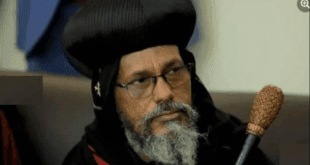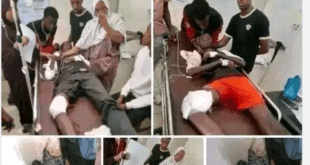January 22, 2014, Addis Ababa (IPS News) — It’s hard to tell if Gelegay Tsegaye is smiling, since a flap of skin covers half his mouth, but his eyes crinkle when he talks and his muffled voice rings with an upbeat cadence. He’s sitting in a special ward of the Korean Hospital in Addis Ababa, Ethiopia’s most modern healthcare facility. Gelegay’s affability is notable because of what he’s gone through. The 34-year-old farmer from a village in Ethiopia’s Gojam region is a survivor of Noma, a rare flesh-eating infection that rots away the face.
When he was just two years old, Gelegay noticed black spots forming on his nose, which quickly spread downwards to his mouth. He received rudimentary treatment, but the diseased part of his face fell off.
Noma is only found amongst children (primary incidence is between the ages of one and four) in the poorest regions of the world, such as rural parts of sub-Saharan Africa and India. The World Health Organisation estimates there are 140,000 new cases globally each year.
Noma’s cause is abject poverty. According to the U.S. Government’s Global Hunger and Food Security Initiative, “Ethiopia is among the poorest countries in the world, with a per capita GDP of 471 dollars.” The initiative states that 38.7 percent of this Horn of Africa’s 80 million people still live below the poverty line.
Noma only occurs in the poorest villages, where adequate healthcare is non-existent. And there are no official figures on the prevalence of the disease in Ethiopia.
The infection can occur when a child living in poverty suffers a cut to the gums. The cut becomes infected and Noma quickly spreads across the face. Within 10 days, 85 percent of its victims are dead.
The survivors may not feel that lucky though, since they’re left with large portions of their face missing. The affliction then becomes social, not medical.

A man suffering from noma
After Gelegay’s face healed, it wasn’t painful, but the disfigurement left him uncomfortable around people. “I used to be very embarrassed to mix with people. They just pushed me away,” he tells IPS.
Here, Noma survivors don’t go to school. They’re usually isolated by their community, their families, or themselves because they don’t feel comfortable around other people.
Yenenesh Yigsaw is a 19-year-old girl from Ethiopia’s Tigray region who also had Noma when she was two.
Yenenesh didn’t realise she was disfigured until she went to school, and soon stopped going.
“It was my decision. I hated being different from all my friends. I always had to walk around with my face covered, and was very embarrassed,” she tells IPS.
Local surgical resident Gersam Abera has never actually worked with or even seen Noma cases before now.
“Usually, they’ll just stay at home. They don’t even seek traditional treatment,” he tells IPS, adding that many people thought of the condition as a punishment from God and not a medical problem.
A few years ago, Gelegay and Yenenesh heard about Facing Africa, a charity group based in the United Kingdom that gives Noma survivors in Ethiopia free reconstructive surgeries.
Fifteen years ago, Englishman Chris Lawrence started the charity so he could help people in a way that he could see with his own eyes.
Lawrence describes his response to seeing Noma for the first time as “sheer anger.”
“Anger that a disease like this, which is caused by malnutrition and extreme poverty, should exist in the twenty-first century,” he tells IPS.
“Noma is not a disease that needs to exist. If it’s caught in the early stages it’s very easily cured.” Simple antibiotics stop the infection dead in its tracks.
“Either they die, or by the time a doctor sees them, half their face is gone,” Lawrence says.
Most people in rural Ethiopia lack local access to antibiotics, and there are no specific government initiatives for tackling Noma.
The infection can only be eliminated by massive upgrades to rural healthcare, sanitation, and nutrition, which can only be done by the government.
However, experts say rural healthcare has significantly improved since the government launched the Health Extension Programme in 2004/2005.
“This programme has massively increased access to the most basic of health services,” Garth Van’t Hul, country director at the charity group CARE Ethiopia, tells IPS. “It was a major contributor in decreasing mortality rates of under-five-year-olds.”
Gelegay has had three procedures to cover up a cavern in his face enveloping his nose and upper mouth, and Yenenesh had two on her cheek.
They both say life has improved since the procedures. Yenenesh has more friends, and people treat her better now.
Gelegay says meeting other patients with Noma has made him feel a lot better.
“At first I was very surprised because I thought I was the only one,” he says.

Fatuma, age 17, Harar
Noma is an acute gangrenous infection affecting the face. Its victims are mainly young children living in extreme poverty, chronically malnourished and with little access to medical care. Some 90 percent die within weeks of contracting this terrible disease, and survivors can be left severely disabled.
The disease was eradicated in Europe and North America a century ago, save for outbreaks in Nazi concentration camps. However, it persists in the world’s ‘noma belt’ – countries, such as Ethiopia, which border the Sahara and have high levels of malnutrition and poor access to medicine. Noma develops when a child’s antibodies that normally fight external viruses become ‘confused’. They turn on their host body, attacking the soft tissue of the cheek, mouth and nose. The World Health Organisation estimates that there are approximately 770,000 survivors of noma, with 140,000 new cases per year.
Survivors are left scarred and disabled. They are frequently unable to eat or speak normally, and confront great social stigma. Many individuals with a facial ‘difference’ are ostracised by their communities, and many of our young patients are denied their right to a school-place or even abandoned. Our patients come from poor, remote regions of Ethiopia, where there is little prospect of treatment without outside help.
Project Harar’s outreach team cover great distances, working with local health workers to contact noma survivors and raise awareness of the treatment available. We arrange free transport to the hospital, accommodation and care. Surgeons in Addis Ababa, assisted by visiting specialists, perform extremely complex surgical procedures to improve facial function and appearance, giving noma victims a new chance in life.
It costs just £250 to reach a child with noma and secure the complex operations and follow-up work which they require to rebuild their lives. If you can help, please click here
——–//——————–
Noma is a type of gangrene that destroys mucous membranes of the mouth and other tissues. It occurs in malnourished children in areas of poor cleanliness.
Alternative Names
Cancrum oris; Gangrenous stomatitis
Causes
The exact cause is unknown, but may be due to bacteria called fusospirochetal organisms. This disorder most often occurs in young, severely malnourished children between the ages of 2 and 5. Often they have had an illness such as measles, scarlet fever, tuberculosis, cancer, or immunodeficiency. Risk factors include Kwashiorkor and other forms of severe protein malnutrition, poor sanitation and poor cleanliness, disorders such as measles or leukemia, and living in an underdeveloped country.
Symptoms
Noma causes sudden, rapidly worsening tissue destruction. The gums and lining of the cheeks become inflamed and develop ulcers. The ulcers develop a foul-smelling drainage, causing breath odor and an odor to the skin. The infection spreads to the skin, and the tissues in the lips and cheeks die. The process can eventually destroy the soft tissue and bone. Eventual destruction of the bones around the mouth cause deformity and loss of teeth. Noma can also affect the genitals, spreading to the genital skin (this is sometimes called noma pudendi).
Exams and Tests
Physical examination shows inflamed areas of the mucous membranes, mouth ulcers, and skin ulcers. These ulcers have a foul-smelling drainage. There may be other signs of malnutrition.
Treatment
Antibiotics and proper nutrition helps stop the disease from getting worse. Plastic surgery may be necessary to remove destroyed tissues and reconstruct facial bones. This will improve facial appearance and the function of the mouth and jaw.
Outlook (Prognosis)
In some cases, this condition can be deadly if left untreated. Other times, the condition may heal over time even without treatment. However, it can cause severe scarring and deformity.
Possible Complications
- Disfigurement
- Discomfort
When to Contact a Medical Professional
Medical care is needed if mouth sores and inflammation occur and persist or worsen.
Prevention
Measures to improve nutrition, cleanliness, and sanitation may be helpful.
References
Chow AW. Infections of the oral cavity, neck, and head. In: Mandell GL, Bennett JE, Dolin R, eds. Principles and Practice of Infectious Diseases . 7th ed. Philadelphia, Pa: Elsevier Churchill Livingstone; 2009:chap 60.




